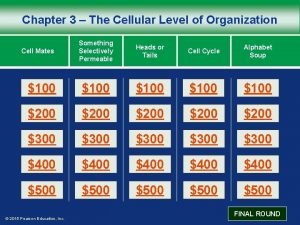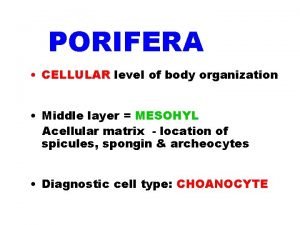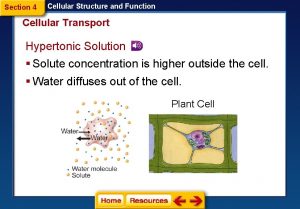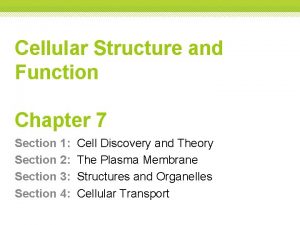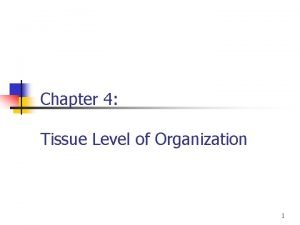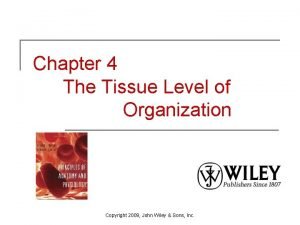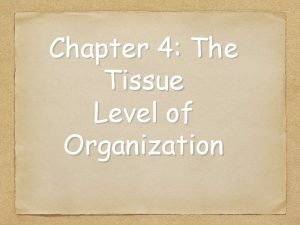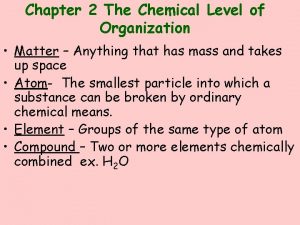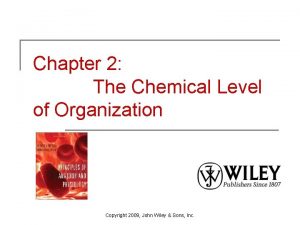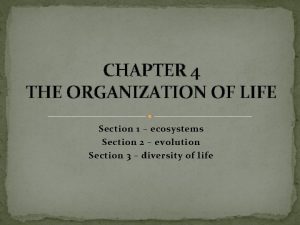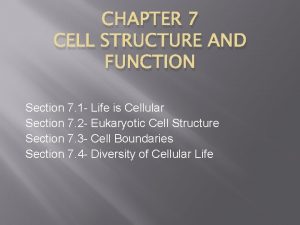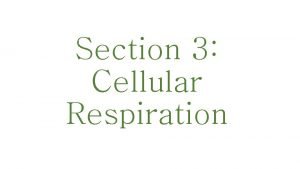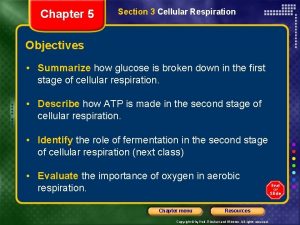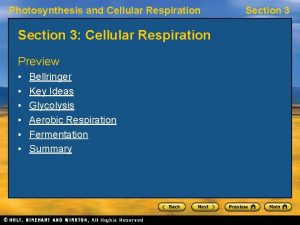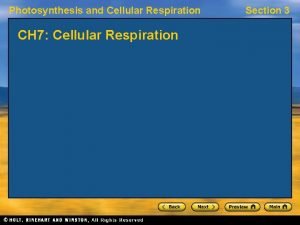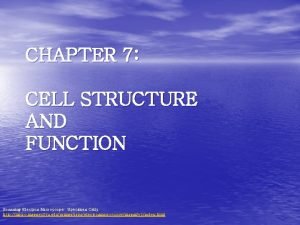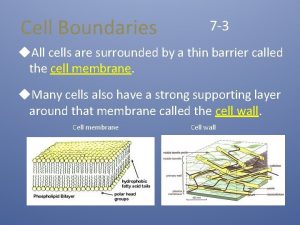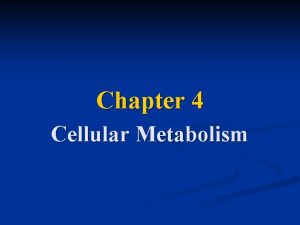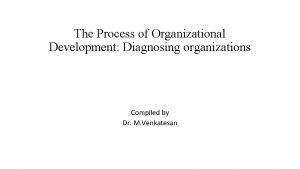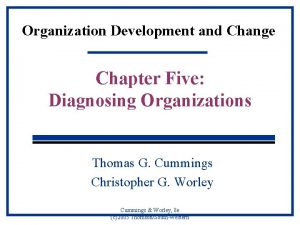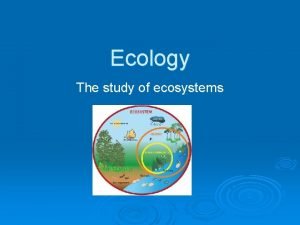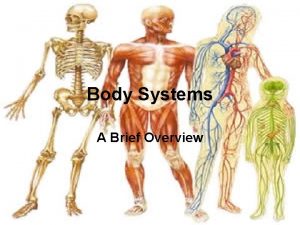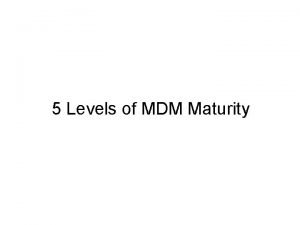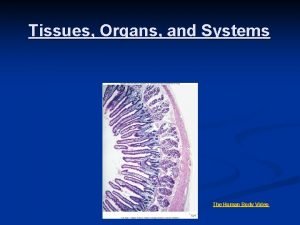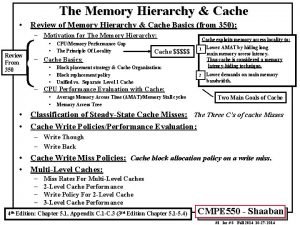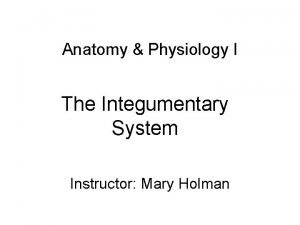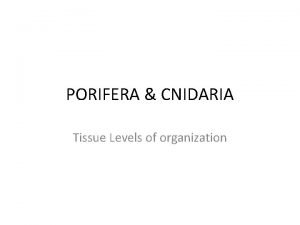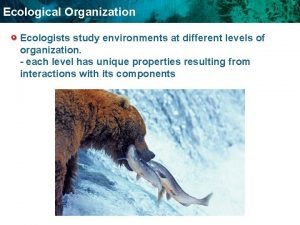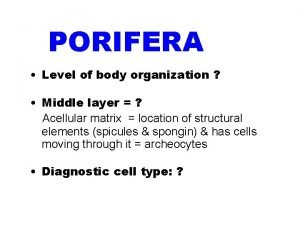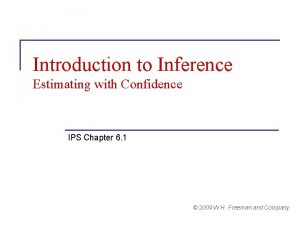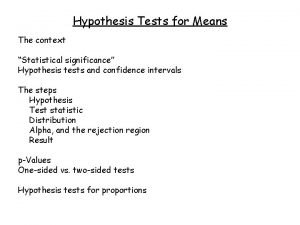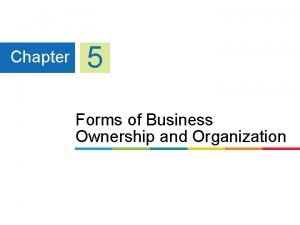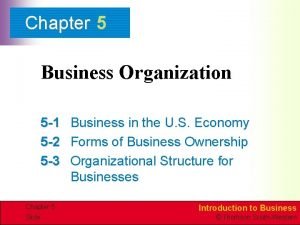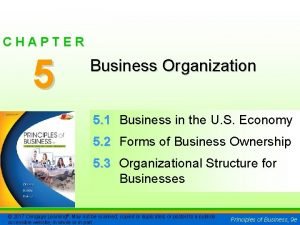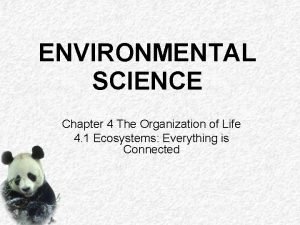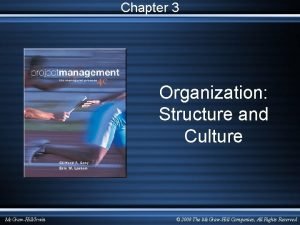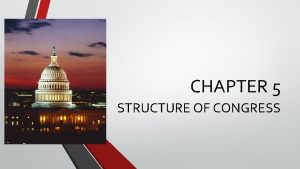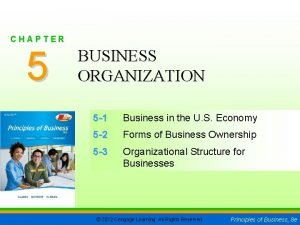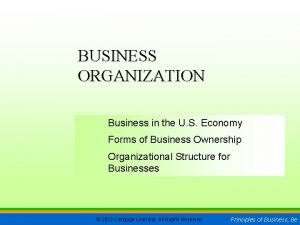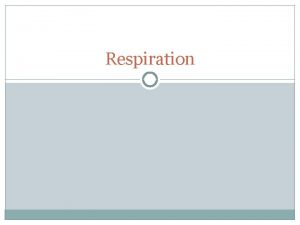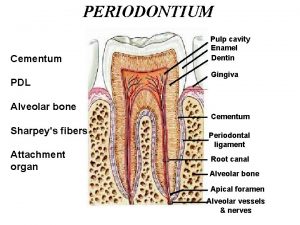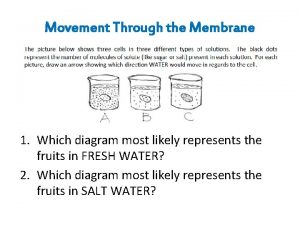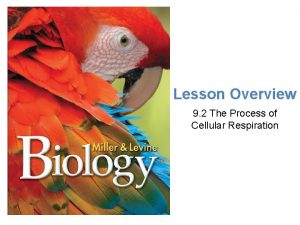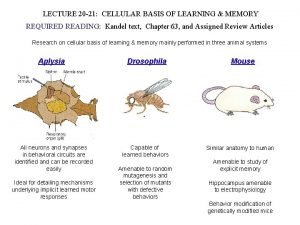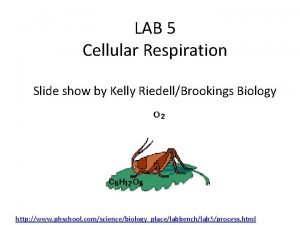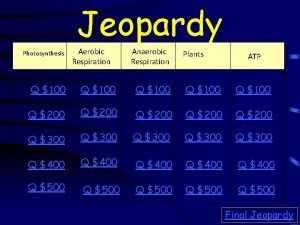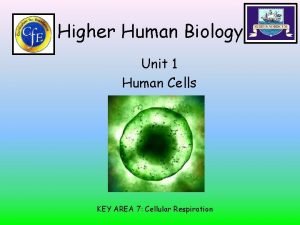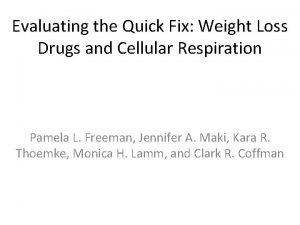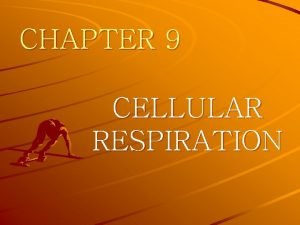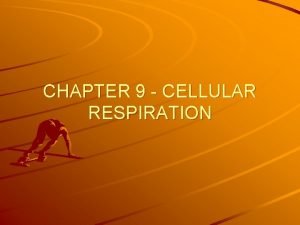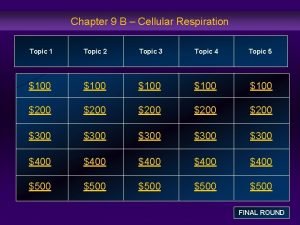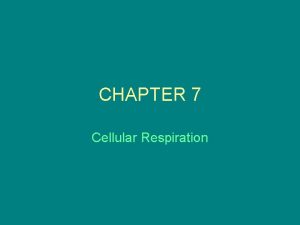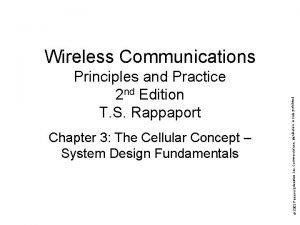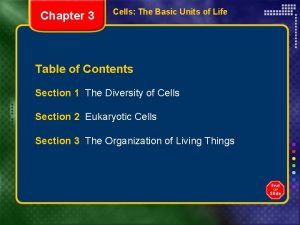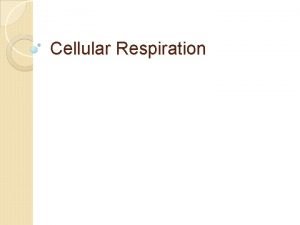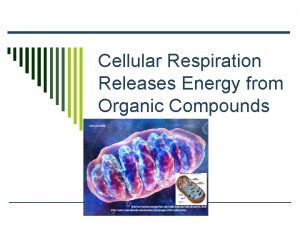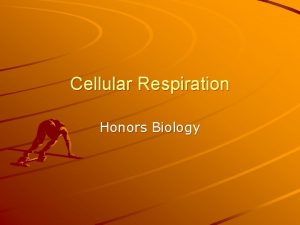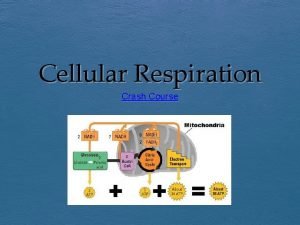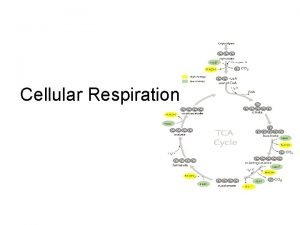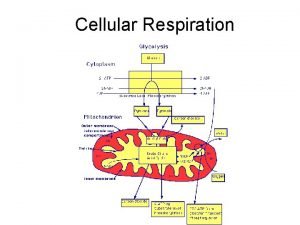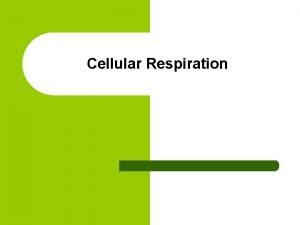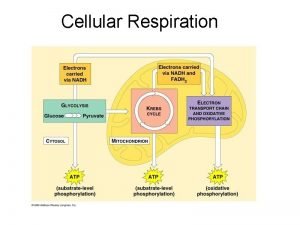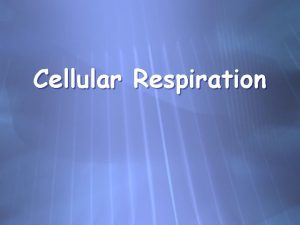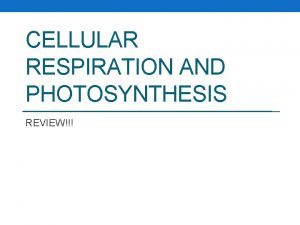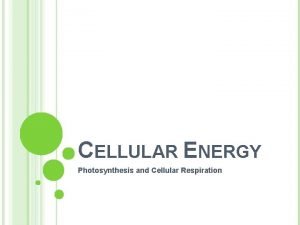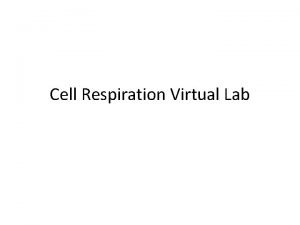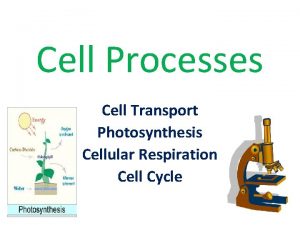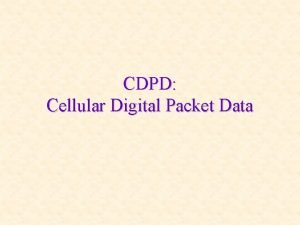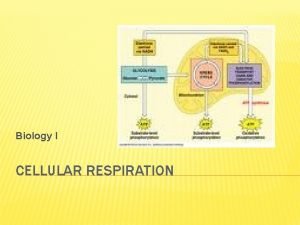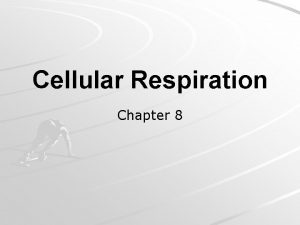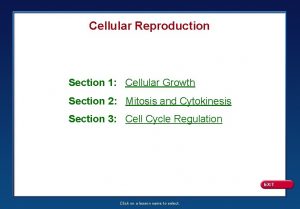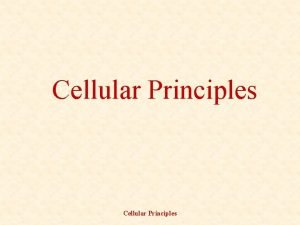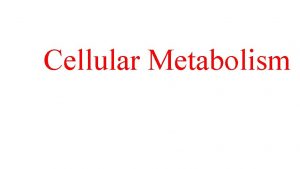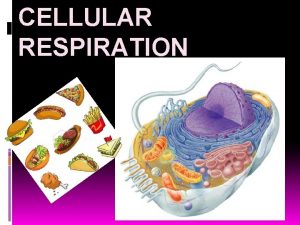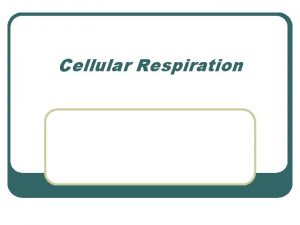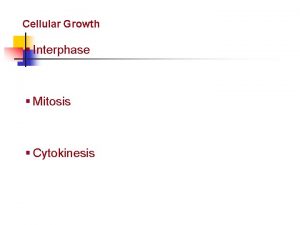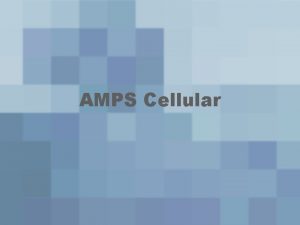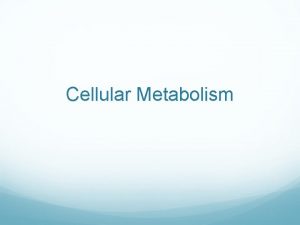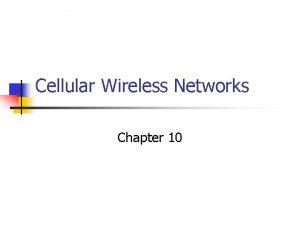The Cellular Level of Organization Chapter 1 Section










































































































































































- Slides: 170

The Cellular Level of Organization Chapter 1 Section 1: Parts of a Cell

Typical Structures Found in a Cell

Plasma Membrane �forms a cell’s flexible outer surface �separates inside from outside �acts as a selective barrier that regulates what gets in or out of cell �plays key role in communication with other cells

Plasma Membrane Fluid Mosaic Model �resembles an ever-moving sea of fluid lipids that has large proteins bobbing along throughout the lipids

Fluid Mosaic Model of Plasma Membrane �membrane proteins either float around like icebergs or are anchored at specific locations

The Lipid Bilayer �basic structure of plasma membrane �made of 2 back-to-back layers using 3 types of lipids �asymmetric

Lipid Bilayer 1 st Lipid Phospholipids 1. ◦ ◦ 75% of lipid membrane lipids with phosphate groups

Lipid Bilayer 2 nd Lipid 2. Cholesterol � 20% of lipid membrane �a steroid �makes bilayer less fluid �weakly amphipathic (-OH group on 1 end can form Hbonds)

Lipid Bilayer 3 rd Lipid �Glycolipids �~5% of membrane lipids �lipid with attached carbohydrate group �stick out into extracellular space

Phospholipids are Amphipathic


Phospholipid Bilayer

“likes like” �hydro: water �philic: loving �phobic: hating �Polar molecules hydrophilic �Nonpolar molecules hydrophobic

Arrangement of Membrane Proteins �Integral Membrane Proteins �embedded in membrane �most are transmembrane: protrude both into cytosol & ECF �amphipathic �Peripheral Protein �loosely ass’c with polar heads of membrane lipids or with integral proteins �inner or outer surface of membrane

Membrane Proteins

Glycoproteins �proteins with carbohydrate groups attached to the ends that protrude into ECF �these carbohydrate groups are oligosaccharides (few-sugars): straight or branched chains of 2 – 60 monosaccharides

Glycoproteins

Glycocalyx �carbohydrate portions of glycolipids + glycoproteins = glycocalyx �acts like name tag for cells to recognize each other

Glycocalyx �enables cells to adhere to each other �protects some cells from being digested by enzymes in ECF

Types & Functions of Membrane Proteins: Integral Proteins ION CHANNELS � are holes or pores thru which specific ions flow in or out of cell � most are very selective � Examples: K+ ion channels 1.

Types of Integral Membrane Proteins 2. TRANSPORTERS �selectively move a polar substance (like water) across the plasma membrane �water transporters called aquaporins �Example: aquaporin

Types of Integral Membrane Proteins RECEPTORS � serve as cellular recognition sites � recognizes & binds specific type of molecule � the specific molecule that binds to a receptor protein is called a ligand 3.

Receptor Proteins

Types of Integral Membrane Proteins 4. ENZYMES �catalyze specific chemical reactions at inside or outside cell

Types of Integral Membrane Proteins 5. LINKERS �integral proteins anchor proteins in the plasma membranes of neighboring cells or to protein filaments inside & outside the cell

Cell-Identity Markers �glycoproteins or glycolipids �Example: ABO blood type markers

Selective Permeability �some substances can easily pass thru, others not at all �lipid-bilayer nonpolar so ◦ permeable to small nonpolar substances ◦ impermeable to polar substances ◦ Water is an exception ◦ is polar ◦ small amts cross plasma membrane

Gradients Across the Plasma Membrane �selective permeability across plasma membrane maintains different concentrations of certain substances on either side of plasma membrane �concentration gradient: a difference in the concentration of a chemical from 1 place to another


Gradients across the Plasma Membrane �because several of the substances kept in different concentrations on either side of membrane have (+) or (-) charges there is an electrical gradient across the membrane �typically, inside surface of membrane is slightly (-) & outside surface of membrane is slightly (+)

Gradients across the Plasma Membrane �a difference in charge across membrane is called: membrane potential

�just like a battery where there is separation of charge used as source of energy so too a membrane potential can be thought of as potential energy for cell to move substances in or out of cell

�The combined influence of the concentration gradient & membrane potential on movement of a particular ion is referred to as its electrochemical gradient

Chapter 3 Section 2 Transport Across the Plasma Membrane

Essential Question �What is the main difference between primary & secondary active transport mechanisms?

Kinetic Energy Transport �diffusion is a passive process in which the random mixing of particles in a solution occurs because of the particle’s kinetic energy �solute: dissolved substances �solvent: liquid that does dissolving

Diffusion �solutes move down their concentration gradient until they are evenly distributed

Diffusion �solute particles continue to move due to their kinetic energy �http: //highered. mcgraw- hill. com/sites/0072495855/student_view 0/chapter 2/animation__how_diffusion_ works. html

Factors that Influence Rate of Diffusion across Plasma Membrane Steepness of Concentration Gradient � greater the difference between 2 sides, higher rate of diffusion � steepness of electrochemical gradient determines rate of diffusion 1.

Factors that Influence the Rate of Diffusion across Plasma Memebrane 2. Temperature �higher temperature higher KE of particles faster it diffuses �all diffusion processes go faster when person has a fever

Factors that Influence Rate of Diffusion across Plasma Membrane 3. Mass of the Solute Diffusing �larger masses diffuse slower than smaller masses

Factors that Influence Rate of Diffusion across Plasma Membrane 4. Surface Area � larger membrane surface area, faster the diffusion rate

Factors that Influence Rate of Diffusion across Plasma Memebrane 5. Diffusion Distance �greater distance over which diffusion must occur, the longer it takes �plasma membranes very thin so diffusion is rapid, processes that thicken that space (autoimmune disease) slow down rate

What Diffuses Across Plasma Membrane �nonpolar, hydrophobic, small molecules: �O 2 & CO 2 gases �Lipids (fatty acids, steroids) �fat-soluble vitamins: ◦ A, D, E, K

Facilitated Diffusion �diffusion through an integral membrane protein from side with higher concentration to side with lower concentration

Facilitated Diffusion

Facilitated Diffusion �transporters very specific �passive process (no nrg output by cell) �# of transporters limited so there is an upper limit to the amount that can cross membrane: called a transport maximum or Tmax �once all transporters occupied the diffusion rate cannot increase


Facilitated Diffusion �http: //programs. northlandcollege. edu/ biology/Biology 1111/animations/passi ve 3. swf

Gated Channels when part of the channel protein acts as a “plug” or “gate” changing shape to open pore & in another shape to close it

Gated Channels �some randomly alternate between open & closed �some regulated by chemical or electrical changes inside & outside cell

Voltage Gated Channels

Osmosis �net movement of water thru selectively permeable membrane ◦ water can move across membrane but solute cannot �water moves down water’s concentration gradient


Osmosis �during osmosis water molecules pass through a plasma membrane in 2 ways: 1. moving thru lipid bilayer 2. moving thru aquaporins


Isotonic Solutions �concentration of solutes that cannot cross membrane same on both sides of membrane �in human body isotonic solution is 0. 9% Na. Cl (normal saline) �allows cells to maintain normal shape & volume


Hypotonic Solution �solution has lower concentration of solutes than the cytosol (higher concentration of water outside cell) �water molecules enter cell faster than they leave cell volume enlarges cell bursts (if RBC called hemolysis)



Hypertonic Solution �solution has a higher concentration of solute than cytosol �water molecules will move out of cell into ECF �RBCs will shrink, called crenation


Crenation


Medical Uses of Isotonic Solutions �IV solutions (intravenous) are isotonic so RBCs will not change shape or volume �example : 0. 9% Na. Cl

Medical Uses for Hypotonic Solutions �given orally or IV used to treat dehydration �water & sports drinks hypotonic

Medical Uses for Hypertonic Solutions �used to treat cerebral edema (increased interstitial fluid around the brain) �example: mannitol ◦ causes excess water in interstitial fluid into blood kidney for excretion in urine

Active Transport �used for polar solutes that must enter or leave cells need to move “uphill” against their concentration gradients �requires cell to spend some energy moving things against concentration gradients

Primary Active Transport �nrg required comes from hydrolysis of ATP (adenosine triphosphate)

ATP Pumps

�a typical body expends 40% of its ATP on primary active transport �most prevalent primary active transport mechanism is the sodium-potassium pump (Na/K pump) part of the pump acts as enzyme ATPase (hydrolyzes ATP) so pump also called: sodium-potassium-ATPase pump

Steps in Na+/K+/ATPase Pump (3) Na+ in cytosol bind to pump 2. that triggers hydrolysis of 1 ATP; phosphate removed attached to pump which changes shape of the pump causing all 3 Na+ to be expelled out into the ECF. This new shape also favors the binding of 2 K+ from ECF onto pump 1.

Steps in Na+/K+/ATPase Pump

Steps in Na+/K+/ATPase Pump 3. binding K+ triggers release of that phosphate group that attached itself in Step 1, releasing it causes change in shape of protein pump 4. when shape changes in Step 3, the 2 K+ are released into the cytosol. Pump now ready to attach 3 Na+ and start over


Na+/K+/ATPase Pump �http: //www. brookscole. com/chemistry_ d/templates/student_resources/shared _resources/animations/ion_pump/ionp ump. html

Why is the Na+/K+/ATPase Pump so Important? �must maintain the different concentrations of Na+ and K+ in order for cells to maintain normal volume & for ability of some cells to generate electrical signals (action potentials in neurons)

Secondary Active Transport �potential electricalchemical nrg stored in concentration gradient of Na+ or H+ is used to push substances across membrane “uphill” (against their concentration gradient) �these concentration gradients established by primary active transport so the 2’ active transport indirectly uses ATP

Secondary Active Transport

Symporters �transporters that move 2 substances in same direction

Antiporters �transporters that move 2 substances in opposite directions across the plasma membrane

Transport in Vesicles �vesicle: small spherical sac formed by membrane

Endocytosis �materials move into cell in a vesicle formed by plasma membrane � 3 Types: 1. Receptor-mediated endocytosis 2. Phagocytosis 3. Pinocytosis

Receptor-Mediated Endocytosis

Receptor-Mediated Endocytosis

Phagocytosis

Macrophage Phagocytosing Bacteria

Pinocytosis �means cell-drinking �tiny droplets of ECF taken into cell �no receptor proteins involved

Exocytosis �releases material from cell �all cells do it but is most important in: 1. Secretory cells that release digestive enzymes, hormones, mucus 2. end of axons on neuron that release neurotransmitters

Exocytosis

�segments of plasma membrane lost in endocytosis and gained in exocytosis �usually evens out �if necessary ER makes more

Chapter 3 Section 3 Cytoplasm & Organelles �Essential Question: �How would you describe the structure & function of the cytoplasm and main organelles of the cell?

Cytosol �same as intracellular fluid �fluid portion of cytoplasm � 55% of cell volume �composition varies from cell to cell: mostly it is 75 -90% water, rest is dissolved & suspended components ◦ ions , glucose, a. a. , fatty acids, lipids, proteins, ATP, waste products

Cytosol �site of many chemical reactions ◦ glycolysis

Cytoskeleton �a network of protein filaments that extends throughout the cytosol

3 Types of Cytoskeleton 1. Microfilaments thinnest of the 3 made of protein actin most prevalent at periphery of cell 2 functions: 1. movement 2. support


Microfilaments �also provide mechanical support for microvilli : fingerlike projections of plasma membrane; function is to greatly increase surface area �abundant in cells of small intestine that absorb

Cytoskeleton 2. Intermediate Filaments medium-sized exceptionally strong (used in parts of cell under mechanical stress) also function to anchor nucleus & attach cells to each other

Intermediate Filaments

Microtubules �largest of cytoskeleton components �Long, unbranched hollow tubes �made mostly of protein tubulin �made in centrosomes an organelle near nucleus �function: cell shape, movement of organelles, chromosomes, flagella, & cilia

Microtubules

Cilia

Flagella

Ribosomes �sites of protein synthesis �made of r. RNA + >50 proteins ◦ 2 subunits: made separately in nucleolus ◦ apart until making protein

Ribosomes �found: in cytoplasm 1. ◦ ◦ called “free” ribosomes make proteins used in cytosol attached to membrane of RER 2. ◦ make proteins to be used by specific organelles or to be exported from cell

Ribosomes

Endoplasmic Reticulum ER �network of membranes in form of flattened sacs or tubules �extend from its connection to nuclear envelope to throughout the cytoplasm � >1/2 membranous surfaces w/in most cells �types: rough or smooth

Rough ER = RER �continuous with nuclear membrane �folded in series of flattened sacs �outer surface RER studded with ribosomes which make proteins that then travel thru spaces of ER for processing & sorting

Proteins made in RER �glycoproteins (proteins + carbohydrate) �lipoproteins membrane (proteins + lipids) �packaged inside vesicles Golgi or directly to export

RER

Smooth ER = SER �makes fatty acids (fa) & steroids �inactivates (detoxifies) drugs & other harmful substances �stores & releases Ca++ that trigger muscle contractions

SER & Drug Tolerance � 1 of functions of liver is to detoxify& it does this because liver cells, hepatocytes, have a lot of SER �prolonged use of a medication or illegal drug causes hepatocytes to increase the amount of SER to accommodate detoxifying extra drug & so person has to take more & more drug to get same affect

SER

Hepatocytes

SER or RER?

Golgi Complex Functions �modifies, sorts, packages, & transports proteins received from RER �forms secretory vesicles that discharge processed proteins via exocytosis into ECF; vesicle membrane then added to plasma membrane

Golgi Complex

Lysosomes Function �digest substances that enter cell via endocytosis & transport final products of digestion into cytosol �autophagy (digestion of worn out organelles) �autolysis (digest entire cell) �extracellular digestion

Lysosomes

Mitochondria �generate ATP thru reactions of aerobic cellular respiration �have a double membrane ◦ both similar to plasma membrane �mitochondrial DNA (maternal) ◦ replicate when demand for ATP increases

Mitochondria

NUCLEUS �Functions: contains genetic information 2. controls cellular structure 3. controls cell activities 4. produces ribosomes in nucleolus 1.

NUCLEUS �usually most prominent structure in cell �most human cells have 1 ◦ mature RBC have 0 ◦ mature WBC have multiple �dbl membrane surrounds it, called nuclear envelope ◦ holes in it called nuclear pores

NUCLEOLUS �prominent, dark, spherical structure in nucleus �site of manufacture of subunits of ribosomes �disperse & disappear during cell division



Name & Function Please 1. 2.

3. 4.

5. 6.

7. 8.

9. 10.

Chapter 3 Section 4 Cell Division �Essential Question: How would you explain the stages and significance of somatic & reproductive cell division?

Definitions �somatic cell: any cell other than ova or sperm �mitosis: nuclear division of somatic cell �cytokinesis: division of cytoplasm �gametes: sex cells, ova or sperm �meiosis: nuclear division of gametes

Definitions �homologous chromosomes: 2 copies of same chromosomes: 1 maternal, 1 paternal �haploid: having only 1 set of chromosomes as found in gametes, designated n �diploid: having 2 sets of chromosomes as found in somatic cells, designated 2 n

Cell Cycle

Cell Cycle �G 0 when cells are not going to go thru cell division again or not for very long periods of time �typically: ◦ G 1 ◦S ◦ G 2 8 – 10 hours 8 hours 4 – 6 hours

Definitions �centromere: constricted portion of a duplicated chromosome; serves as point of attachment for microtubules that pull chromatids apart during anaphase �kinetochore: protein complex attached to outside of centromere

Definitions �mitotic spindle: collective term for a football-shaped assembly of microtubules that is responsible for movement of chromosomes during mitosis �sister chromatids: pair of identical DNA strands that are joined at the centromere and separate during mitosis becoming a chromosome of 1 of 2 daughter cells

Chromosomes

Mitosis

Mitotis Phases: Prophase 1. ◦ ◦ Early Prophase chromatin condenses & shorten into chromosomes visible under light microscope made up of sister chromatids with centromere

Late Prophase �mitotic spindle begins to form extending to poles of cell

Metaphase �microtubules align the centromeres at exact center of mitotic spindle �called metaphase plate

Anaphase �centromeres split & sister chromatids move toward opposite poles �once separated chromatids called chromosomes

Telophase �identical sets of chromosomes now at opposite poles of cell �chromosomes uncoil chromatin �nuclear envelope re-forms �cleavage furrow starts to form

Cytokinesis �division of cytoplasm completed �cleavage furrow usually midway between poles (actin microfilaments form a contractile ring) �organelles on each side

Mitosis �start with parent cell with diploid # chromosomes (46) �ends with 2 daughter cells each with a diploid # of chromosomes (46) genetically the same as parent cell

Name That Stage of Mitosis 1. 2.

3. 4.

5. 6.

Control of the Cell Cycle �Cells have 3 choices: 1. Keep going thru Cell Cycle 2. enter G 0 3. Die Homeostasis is maintained when there is a balance between cell proliferation & cell death

Cell Cycle Regulation �cyclins are proteins that are responsible for activating enzymes called Cdks (cyclin-dependent protein kinases) �Cdks transfer a phosphate group from ATP to a protein which activates the protein; other enzymes remove the phosphate group thus de-activating it

Cell Cycle Regulation �activation/deactivation of Cdks is crucial to DNA replication, mitosis & cytokinesis �activation of specific cyclin-Cdk complexes responsible for a cell going from G 1 S G 2 mitosis

Cell Death �apoptosis: programmed cell death �trigger from outside or inside cell causes “cell-suicide” genes to produce enzymes that damage the cell in several ways �phagocytes (cells that engulf debris, bacteria; “clean-up crew”) ingest the dying cell

Apoptosis �removes unneeded cells during fetal development (like webbing between digits) �eliminates potentially harmful cells like cancer cells

Tumor-Suppressor Genes �produce proteins that inhibit cell division �damage to these genes causes some types of cancer �example: p 53 is a tumor-suppressor gene on chromosome 17 which normally arrests cells in G 1 & assists in repair of DNA… if repair not successful p 53 induces apoptosis of that cell ◦ abnl in this gene have led to different cancers (breast, colon)


Meiosis �for reproduction of sex cells �must have haploid # so when ova & sperm unite offspring will have normal diploid # of chromosomes �starts with diploid cell meiosis 4 daughter cells each with a haploid # of chromosomes (23) that are genetically different than original cell

Meiosis

Meiosis I: Prophase I � homologous chromosomes matched up (called synapse) and do a little trading of alleles (crossing over): results in genetic variation: the 4 daughter cells will be genetically different

Crossing Over

Meiosis I Metaphase I �homologous chromosomes line up on metaphase plate Anaphase I �homologous chromosomes move to opposite poles

Meiosis I �Telophase I �nuclear envelopes re -form �each nucleus has 23 duplicated chromosomes �Cytokinesis I � 2 daughter cells each with n chromosomes (in duplicated state)

Meiosis II Prophase II Metaphase II

Meiosis II Anaphase II Telophase II

Meiosis II

Homeostatic Imbalances Cancer �Large group of diseases characterized by uncontrolled or abnormal cell proliferation �Abnl cells also called: ◦ Tumor ◦ Malignancy ◦ Neoplasm Metastasis: cells spread from organ of origin

Causes of Cancer �Carcinogen: chemical or radiation that causes cancer �Carcinogens cause DNA mutations (permanent changes in DNA) �Oncogenes: cancer-causing genes �Oncogenic Viruses: stimulate abnl proliferation of cells (HPV, Hepatitis. C)
 Chapter 3 the cellular level of organization
Chapter 3 the cellular level of organization Level of organization in porifera
Level of organization in porifera Molecular level vs cellular level
Molecular level vs cellular level Chapter 8 section 3 cellular respiration
Chapter 8 section 3 cellular respiration Chapter 9 section 1 cellular growth
Chapter 9 section 1 cellular growth Section 4 cellular transport
Section 4 cellular transport Chapter 9 section 1 cellular growth
Chapter 9 section 1 cellular growth Chapter 7 section 4 cellular transport
Chapter 7 section 4 cellular transport Chapter 4 the tissue level of organization
Chapter 4 the tissue level of organization Chapter 4 the tissue level of organization
Chapter 4 the tissue level of organization Chapter 4 the tissue level of organization
Chapter 4 the tissue level of organization The chemical level of organization
The chemical level of organization The chemical level of organization chapter 2
The chemical level of organization chapter 2 Chapter 4 the organization of life section 1
Chapter 4 the organization of life section 1 Cellular energy section 2 photosynthesis answer key
Cellular energy section 2 photosynthesis answer key Section 7-1 life is cellular
Section 7-1 life is cellular Diffrences between plant and animal cells
Diffrences between plant and animal cells Section 3 cellular respiration
Section 3 cellular respiration Section 4 cellular transport answer key
Section 4 cellular transport answer key Section 3 cellular respiration worksheet answers
Section 3 cellular respiration worksheet answers Section 3 cellular respiration
Section 3 cellular respiration Section 3 cellular respiration continued
Section 3 cellular respiration continued Section 1 how organisms obtain energy
Section 1 how organisms obtain energy Section 7-4 the diversity of cellular life
Section 7-4 the diversity of cellular life Section 7-4 the diversity of cellular life
Section 7-4 the diversity of cellular life Process organization in computer organization
Process organization in computer organization Difference between block and point-by point organization
Difference between block and point-by point organization Chapter 10 section 1 meiosis worksheet answer key
Chapter 10 section 1 meiosis worksheet answer key Chapter 8 lesson 1 life is cellular
Chapter 8 lesson 1 life is cellular Chapter 4 cellular metabolism
Chapter 4 cellular metabolism The stages of cellular respiration
The stages of cellular respiration Explain how amp stimulates cellular respiration
Explain how amp stimulates cellular respiration Chapter 9: cellular respiration: harvesting chemical energy
Chapter 9: cellular respiration: harvesting chemical energy Chapter 9 cellular reproduction
Chapter 9 cellular reproduction Nondisjunction in meiosis
Nondisjunction in meiosis Hình ảnh bộ gõ cơ thể búng tay
Hình ảnh bộ gõ cơ thể búng tay Bổ thể
Bổ thể Tỉ lệ cơ thể trẻ em
Tỉ lệ cơ thể trẻ em Chó sói
Chó sói Tư thế worm breton
Tư thế worm breton Hát lên người ơi alleluia
Hát lên người ơi alleluia Môn thể thao bắt đầu bằng chữ f
Môn thể thao bắt đầu bằng chữ f Thế nào là hệ số cao nhất
Thế nào là hệ số cao nhất Các châu lục và đại dương trên thế giới
Các châu lục và đại dương trên thế giới Công thức tính độ biến thiên đông lượng
Công thức tính độ biến thiên đông lượng Trời xanh đây là của chúng ta thể thơ
Trời xanh đây là của chúng ta thể thơ Mật thư anh em như thể tay chân
Mật thư anh em như thể tay chân Phép trừ bù
Phép trừ bù độ dài liên kết
độ dài liên kết Các châu lục và đại dương trên thế giới
Các châu lục và đại dương trên thế giới Thơ thất ngôn tứ tuyệt đường luật
Thơ thất ngôn tứ tuyệt đường luật Quá trình desamine hóa có thể tạo ra
Quá trình desamine hóa có thể tạo ra Một số thể thơ truyền thống
Một số thể thơ truyền thống Bàn tay mà dây bẩn
Bàn tay mà dây bẩn Vẽ hình chiếu vuông góc của vật thể sau
Vẽ hình chiếu vuông góc của vật thể sau Biện pháp chống mỏi cơ
Biện pháp chống mỏi cơ đặc điểm cơ thể của người tối cổ
đặc điểm cơ thể của người tối cổ V cc
V cc Vẽ hình chiếu đứng bằng cạnh của vật thể
Vẽ hình chiếu đứng bằng cạnh của vật thể Fecboak
Fecboak Thẻ vin
Thẻ vin đại từ thay thế
đại từ thay thế điện thế nghỉ
điện thế nghỉ Tư thế ngồi viết
Tư thế ngồi viết Diễn thế sinh thái là
Diễn thế sinh thái là Dot
Dot Thế nào là số nguyên tố
Thế nào là số nguyên tố Tư thế ngồi viết
Tư thế ngồi viết Lời thề hippocrates
Lời thề hippocrates Thiếu nhi thế giới liên hoan
Thiếu nhi thế giới liên hoan ưu thế lai là gì
ưu thế lai là gì Khi nào hổ con có thể sống độc lập
Khi nào hổ con có thể sống độc lập Sự nuôi và dạy con của hổ
Sự nuôi và dạy con của hổ Hệ hô hấp
Hệ hô hấp Từ ngữ thể hiện lòng nhân hậu
Từ ngữ thể hiện lòng nhân hậu Thế nào là mạng điện lắp đặt kiểu nổi
Thế nào là mạng điện lắp đặt kiểu nổi Organization level
Organization level Organization-level diagnostic model
Organization-level diagnostic model Organizational level
Organizational level What is the least complex level of organization
What is the least complex level of organization Levels of organization in ecology
Levels of organization in ecology Level of organization organ system
Level of organization organ system Levels of data management
Levels of data management Smallest to largest level of organization
Smallest to largest level of organization Middle level management examples
Middle level management examples Three level cache organization
Three level cache organization What level of organization
What level of organization Cnidaria organization level
Cnidaria organization level What is top management
What is top management What do global ecologists study
What do global ecologists study Ostia in porifera
Ostia in porifera Isis protocol
Isis protocol Significance and confidence level
Significance and confidence level Isis level 1 vs level 2
Isis level 1 vs level 2 Significance level and confidence level
Significance level and confidence level Confidence level and significance level
Confidence level and significance level Budi definition
Budi definition Security level 0
Security level 0 Costa's level questions
Costa's level questions Thread level parallelism in computer architecture
Thread level parallelism in computer architecture Low-level thinking in high-level shading languages
Low-level thinking in high-level shading languages Pfp cut off
Pfp cut off Dimensioning section views
Dimensioning section views Removed section definition
Removed section definition Example of full section view
Example of full section view Chemical potential energy images
Chemical potential energy images The organization of congress chapter 5
The organization of congress chapter 5 5 forms of business ownership
5 forms of business ownership Chapter 5
Chapter 5 Chapter 5 business organization
Chapter 5 business organization Environmental science chapter 4 the organization of life
Environmental science chapter 4 the organization of life Chapter 3 planning organization and management
Chapter 3 planning organization and management Organizational culture diagnosis worksheet
Organizational culture diagnosis worksheet The organization of congress chapter 5
The organization of congress chapter 5 Chapter 5 business organization
Chapter 5 business organization The company chapter 5
The company chapter 5 Redox reaction in cellular respiration
Redox reaction in cellular respiration What is the correct equation for cellular respiration?
What is the correct equation for cellular respiration? Chemiosmosis steps
Chemiosmosis steps Aerobic vs anaerobic
Aerobic vs anaerobic Fermentering
Fermentering Why is cellular respiration important
Why is cellular respiration important The process of photosynthesis and cellular respiration
The process of photosynthesis and cellular respiration Cellular respiration chemical equation
Cellular respiration chemical equation Amloplast
Amloplast Equation for photosynthesis
Equation for photosynthesis Site:slidetodoc.com
Site:slidetodoc.com Photosynthesis recipe card
Photosynthesis recipe card Cellular network range
Cellular network range What happens during glycolysis
What happens during glycolysis Overview of cellular respiration
Overview of cellular respiration Overview of cellular respiration
Overview of cellular respiration Cellular respiration
Cellular respiration Overview of cellular respiration
Overview of cellular respiration Cellular basis of learning and memory
Cellular basis of learning and memory Lab bench cellular respiration
Lab bench cellular respiration Cellular system
Cellular system Diatoms unicellular or multicellular
Diatoms unicellular or multicellular What is the word equation for cellular respiration
What is the word equation for cellular respiration Cellular events of acute inflammation
Cellular events of acute inflammation 5 cardinal signs of inflammation
5 cardinal signs of inflammation Higher human biology cellular respiration
Higher human biology cellular respiration Dnpask
Dnpask Cellular respiration and photosynthesis equation
Cellular respiration and photosynthesis equation What are the reactants and products of photosynthesis?
What are the reactants and products of photosynthesis? Cellular respiration releases
Cellular respiration releases Starting materials for cellular respiration
Starting materials for cellular respiration Redox reaction in cellular respiration
Redox reaction in cellular respiration Cellular system design fundamentals
Cellular system design fundamentals Organelle
Organelle Cellular vs plasmodial slime molds
Cellular vs plasmodial slime molds Where in the cell does cellular respiration occur
Where in the cell does cellular respiration occur Role of cellular respiration
Role of cellular respiration Cellular respiration releases
Cellular respiration releases Cellular respiration redox
Cellular respiration redox Respiration crash course
Respiration crash course Cellular respiration
Cellular respiration Cellular respiration process diagram
Cellular respiration process diagram Overall reaction of cellular respiration
Overall reaction of cellular respiration Cellular respiration occurs in
Cellular respiration occurs in Electron transport chain cellular respiration
Electron transport chain cellular respiration Where does cellular respiration take place
Where does cellular respiration take place Function of cellular respiration
Function of cellular respiration Cellular respiration endothermic or exothermic
Cellular respiration endothermic or exothermic What are the net products of the krebs cycle
What are the net products of the krebs cycle Function of cellular respiration
Function of cellular respiration Photosynthesis and cellular respiration virtual lab
Photosynthesis and cellular respiration virtual lab Equation for cellular respiration
Equation for cellular respiration Cdpd provides low cost wireless data services to
Cdpd provides low cost wireless data services to Cellular respiration chemical equation
Cellular respiration chemical equation
